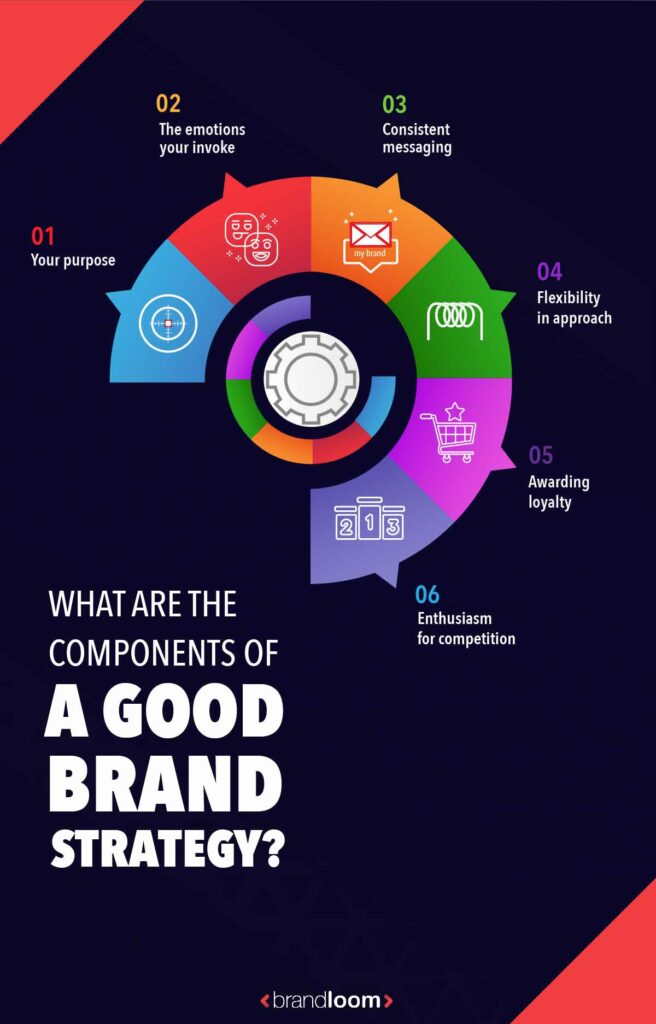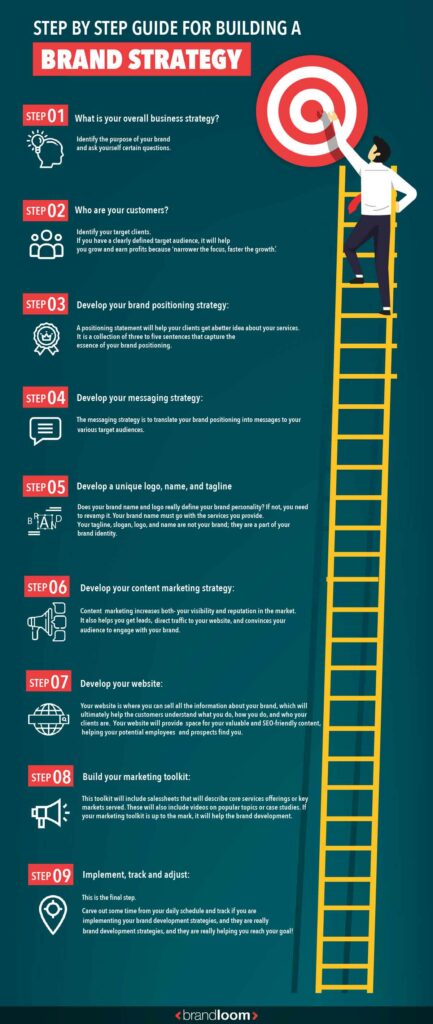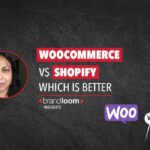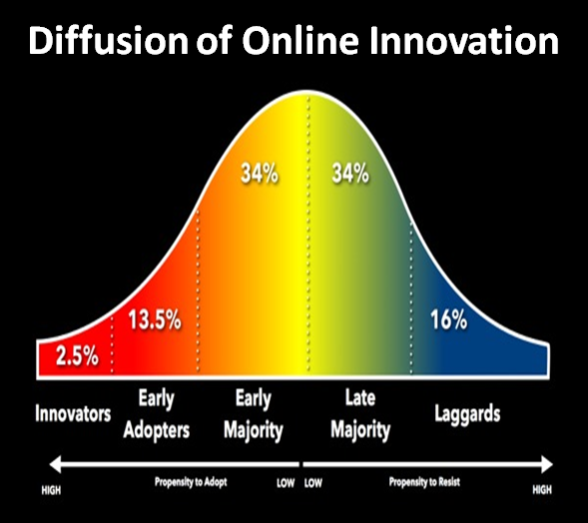What do you think a brand is? Is it limited to a logo, name, slogan, or product? Well, it’s more than that. Merely selecting a logo and creating a unique slogan won’t bring goodwill and profit. Your brand covers the entire experience your customers have with your company. To earn goodwill and make your space in the market, you need a good brand strategy.
In this blog, you will learn what is a brand strategy and how to build one.
What is a brand strategy?
Suppose you have a brand with an attractive logo, a catchy slogan, and you sell quality products. Do you think that’s enough to guarantee its survival and growth?
This is why you need a good brand strategy in place. A brand strategy not only helps you define who you are and who you are speaking to but also has a vision for evolution.
In order to build a sustainable brand, engage its customers, build up a steady base and cement its reputation; a brand needs to have a clear blueprint for growing.
Every brand needs to consider the following questions to define its brand strategies:
- Who are your customers?
- What is the objective of your brand?
- How does your brand define long-term success?
Knowing these answers will help you find the best way to approach your target audience.
Logo, color palette, and slogans are only some of the creative elements that convey your brand. Other aspects – how your employees interact with your customers, what your customers think about your brand, and what message you deliver on your website or campaigns- communicate what your brand stands for.
A Brand strategy is a LONG TERM plan that helps a Brand achieve its SMART GOALS.
AVINASH CHANDRA
A Brand strategy is destined to achieve Specific, Measurable, Achievable, Realistic, and Time-Bound Goals.
So, if you want to grow, you must send out the right message to the audience via both your communication and business practices. How that message is delivered effectively, and how it can work towards sustaining your business forms the crux of your brand strategy.

Why does your brand need a defined brand strategy?
Successful branding creates brand equity. People would want to spend their money on your product just because it’s your product. Brand strategy is precisely the way you build up this equity.
The best example of a brand with high brand equity is Apple. Apple launches almost similar products in terms of features, yet their fan following is huge, and people want to buy their product just because Apple launched it.
They have achieved this recognition because they knew how to approach their customers. Their brand personality is about lifestyle, hopes, dreams, and aspirations. They were aware of the demands of their audience and found a way to communicate with them and function as a business that has ensured that they are here for the long term.
All in all, Apple is an example of designing and executing a good brand strategy.
What are the types of branding strategies?
Branding strategies come in different forms. While there is no universally applicable classification for them, roughly, they are regarded to be of five types:
Personal Branding Strategy
Here, an individual IS a brand. Think of life coaches, motivational speakers, or even experts like Marie Kondo. They have expertise in a particular field, and their brand is about establishing themselves as authority figures. The idea here is to build a brand around a person in a way that feels like a natural extension of their personality.
Product Branding Strategy
This is self-explanatory. When you have a tangible product, you build a brand around it in a way that it stands out from its competitors. Think of Coca-Cola- the drink has an instantly identifiable label, packaging design, logo, and slogan which sets it apart.
Corporate Branding Strategy
Corporate branding is about developing an overarching brand for an entity that has multiple brands or products under its umbrella. If you are looking for an example, what can be better than Tata? The highly diversified conglomerate has a set of principles, values, and mission that informs ALL its businesses. By virtue of being a product of the Tata Group, brands like Tanishq or Tata Salt command prestige in the market.
Attitude Branding Strategy
This applies to companies that go beyond a product- and come to embody an attitude or mood. Think of Nike- a sportswear brand that stands for a lifestyle instead of any individual products. Its signature is its tagline “Just do it”, which stands for passion, drive, motivation, and confidence. This is why it remains such a popular brand even among non-athletes.
Local Branding Strategy
When small businesses want to stand apart from the local competition, they engage in local branding. Think of Mumbai’s famous Café Leopold or Bade Miyan. Both are extremely popular food joints, located in the same area- but have built up their own following by defining themselves in sharp contrast to each other.
Apart from these branding strategies, we are seeing other types like media branding or location branding. Media branding applies to media channels and platforms that want to carve out a specific image for themselves and attract a specific crowd. Platforms like TED are a great example of media branding.
On the other hand, location branding works mainly for events that attract a niche audience and are held in one particular location. Think of the popular music and film festivals like Coachella, Sundance, Woodstock, or SXSW- they are location-specific events that have developed a distinct image and appeal to very distinct crowds.
Do you have a brand strategy in place?
How do we know if our company follows a defined brand strategy? Let’s look at the following three cases and identify the status of your brand:
BEST CASE:
- Your customers and prospects know what you deliver, and there is less convincing needed because they already know what you stand for.
- You can charge a premium for your products or services because people know why you are better, and they are willing to pay for it.
NEUTRAL CASE:
- You have not thought about branding yet because you think it’s not needed, but you know you can do a better job if you communicate consistently with the market.
- You are not earning profits, but you are not at a loss either.
WORST CASE:
- You don’t have a brand strategy at all, and the communication between you and your prospects becomes difficult because they don’t know much about your brand.
- What you say, what you do, and what you stand for contradict each other and confuse the customers and the prospects.
If your brand belongs to the neutral or worst case group, then you must prepare yourself and work on a defined brand strategy for your brand.
Learn more about Challenges and Opportunities of Branding
What are the components of a good brand strategy?
If you are making a brand strategy, make sure that you consider the following points:
1. Your purpose
What does your brand promise your audience? Yes, every brand wants to sustain itself- but what service does it pledge towards its prospects and customers? This is what is laid out in the company’s Mission and Vision statements. After all, your brand needs a good reason to exist that goes beyond scoring profits.
2. The emotions you invoke
People don’t always go by the rationale when making a purchase. They can- but it’s not the reason they stay invested in a brand. That comes from the place of emotions. When your audience can relate to, identify with, and appreciate your brand’s values, its message, and its mission- they become emotionally invested in it. Not only do they become loyal followers, but they also act as your unofficial ambassadors.
A good example of this is the Nike fandom. Nike has a strong emotional appeal, and as a result, it has emerged as one of the most powerful brands in the world. Not only do Nike users keep going back to it, but also act as its staunch defenders in times of crisis- which became apparent during the Colin Kaepernick fallout.
3. Consistent messaging
Brand building 101 states that your brand’s values and central message stay the same through the ages. You have to be consistent across all media and platforms, and find new ways to convey them so that you can build brand loyalty across generations and geographies.
4. Flexibility in approach
Naturally, if you want to survive and grow through changing times, your brand should be malleable in its approach. When your brand strategy has room for change, your brand can be flexible and adapt to new situations. Otherwise, it will stagnate and become irrelevant. Think of brands like HMV. They quickly lost ground to competitors by refusing to compromise on pricing, and with time, nearly vanished.
5. Awarding loyalty
If your brand has followers- you must show your appreciation for them. This is the reason why many brands have loyalty programs. However, you must go beyond that. Offer your loyal customers personalized experiences, ask them for testimonials and feature them on your brand channels. This not only shows them that you appreciate them, but also that they are participants in your brand.
6. Enthusiasm for competition
Finally, your brand strategy should always refer to what your competitors are doing, and have the spirit to go neck to neck with them. A market is a tough place, and if you slack off, your competitors will take the lead. You must stay alert and continuously audit the competition to understand what you need to do better.
A great example of this is Wendy’s, the sassy fast-food brand that is famous for dissing other fast-food brands in funny ways. In the process, Wendy’s has built up a highly engaged social media base.
Your brand strategy should be designed so that it takes all the above factors into consideration.
Now, let us look at a step-by-step guide for building a brand strategy.

Step by step guide for building a brand strategy
1 What is your overall business strategy?
Identify the purpose of your brand and ask yourself certain questions, like:
- What type of firm do you want?
- Are you planning to grow organically?
If you are clear about where you want to take your firm, your brand will help you get there.
2. Who are your customers?
Identify your target clients. If you think you will sell your product to everyone, you are making a big mistake. If you have a clearly defined target audience, it will help you grow and earn profits because ‘narrower the focus, faster the growth. Study their perspective and priorities. You need to anticipate their needs and communicate them in a language that resonates with them.
3. Develop a unique logo, name, and tagline:
Does your brand name and logo really define your brand personality? If not, you need to revamp it. Your brand name must go with the services you provide. If you don’t want to touch the brand name- then a strong, creative, unique, and memorable tagline and logo may support your brand positioning.
But do not muddle things up, and remember that your tagline, slogan, logo, and name are not your brand; they are a part of your brand identity.
Show the samples of your new logo and tagline to the target market and not your internal employees. It will help you get a better idea about how well they communicate to the audience.
4. Develop your brand positioning strategy:
It’s time to identify your market positioning. What makes your brand different from others, and why would a potential customer choose you over your competitors? A positioning statement will help your clients get a better idea about your services.
A positioning statement is a collection of three to five sentences that capture the essence of your brand positioning. So be creative and precise while creating one. Also, it must be a bit aspirational.
5. Develop your messaging strategy:
The messaging strategy is to translate your brand positioning into messages to your various target audiences. Accordingly, design what your communication strategy should be. What words will you use? What values will you talk about? Decide what will go on your online and offline spaces, and what format your content will be. Also look at who will deliver your message.
6 Develop your content marketing strategy:
Well-written and valuable content will attract, nurture and qualify prospects. Content marketing increases both- your visibility and reputation in the market. It’s the perfect way to make your brand relevant to your target audience.
It also helps you get leads, direct traffic to your website and convinces your audience to engage with your brand. With good content, you can also nudge them towards making purchase decisions.
7 Develop your website:
Your website is where you can sell all the information about your brand, which will ultimately help the customers understand what you do, how you do, and who your clients are. In a world where customers’ first instinct is to look at your website- you must ensure that your website has all the necessary information and ensures a quality brand experience for your customers.
Furthermore, your website will provide space for your valuable and SEO-friendly content, helping your potential employees and prospects find you. Hence, it is essential to build an effective website.
8 Build your marketing toolkit:
This toolkit will include sales sheets that will describe core service offerings or key markets served. These will also include videos on popular topics or case studies. If your marketing toolkit is up to the mark, it will help the brand development.
9 Implement, track and adjust:
This is the final step. Sometimes people make strategies and start with good intentions, but later they get so busy with client’s work that they hardly get time to focus on their brand development.
This can have negative implications. Therefore, we recommend you carve out some time from your daily schedule and track if you are implementing your brand development strategies, and they are really helping you reach your goal!

Conclusion:
A solid brand strategy can transform your small business into a major market player. All it takes is consistency, patience, creativity, focus, and a plan. All this together will develop a deeper level of trust in the customers with your brand.
Also, remember that your brand strategy should address YOUR needs and YOUR vision. There is no one-size-fits-all strategy that can suit all brands. So, make sure that your brand strategy is tailor-made for you.
Connect with us and let us help you build your brand. Our team of brand strategists combines business, marketing, communications, and design thinking to develop meaningful, differentiated, and authentic brands for companies big and small, start-ups or stalwarts.
FAQ
What are the 4 branding strategies?
There are 4 common types of branding strategies:
Personal branding:
When the brand develops around a personality, and the branding strategy is about establishing that person as an authority in a field and a thought leader in the market.
Product branding:
When you have a tangible product, you can build a brand around you. Literally, any product you use today is an example of a product brand- like Tata Salt or Bata shoes.
Corporate branding:
This is about branding for the umbrella brand under which a number of distinct brands exist. Think of conglomerates like Bajaj or ITC. They have very distinct business verticals- but all of them follow some common values and approaches which target a specific range of target audiences.
Local branding or private-label branding:
This is what small businesses do to stand out from their local competitors. You can look at any two shops in your neighborhood market that sell the same item- and you will understand how local branding works. In these cases, the brands want to distinguish themselves as the best brand in a community and communicate accordingly with the customers.What are some brand strategies?
When it comes to growing your brand, there are four strategies that should be looked at:
Line extension brand strategy
This is the type of strategy in which a brand launches new products for its target audience. When you see phone companies launching new models, it falls under this category.
Brand extension brand strategy
This happens when a brand starts offering products or services in a field related to their core. For example, when celebrity stylist Rachel Zoe launched her own fashion line- it was an example of brand extension. Her line featured items of the “boho chic” aesthetic- a look that she is regarded as the pioneer of.
New brand strategy
This is when a brand launches a new brand under its umbrella. Think of Unilever launching Tresemme shampoos after cementing a line of Dove shampoos. Brands do this because they want to extend their reach to different price segments.
Flanker brand strategy
Brands often launch “sub brands” for new price segments. For example, the P&G brand Ariel has recently launched Ariel Perfect Wash- which is the more pocket-friendly variant of their washing powder.What is the role of brand strategy?
A brand strategy’s purpose is to create a blueprint for a brand’s growth. From choosing the name and logo, to deciding on its corporate practices, its USP, messaging strategy and choice of brand ambassador- everything is a part of the brand strategy. The brand strategy informs every business decision a company takes and every piece of communication that goes in its name. It shapes the personality of the brand and defines its core values- which forms the basis of every action to be taken by the brand.
What are 4 types of brands?
There is no definite classification of brands. However, there is a loose consensus that all brands can be grouped into 4 groups:
Personal brand:
When a brand develops around an individual. Think of marketing guru Seth Godin. He is a brand in himself- people have some expectations from him, hence they keep signing up for what he offers.
Service brand- these are brands that offer a particular service. Airlines are a great example of this category.
Organization brands:
These are organizations or companies that have a set of products which all imbibe a set of distinct characteristics. Think of Christian Louboutin- the luxury designer brand known for its shoes. The shiny red bottom of the shoes, and their higher than 4-inch heels are their signature marks. The company has fought (and won) various other designers who have tried to emulate the red bottom look.
Product brands:
This is the most common type of brand. Every brand can be an individual brand. Think of Red Bull drinks- which has a very distinct look and feel, and an irreverent attitude that sets it apart from its competitors.What is a good branding strategy?
A good branding strategy is one that incorporates the following elements:
A strong purpose:
A brand stands for something. Your values and principles are what define your purpose. For example, Tesla defines its mission as “to accelerate the world’s transition to sustainable energy”.
Clear understanding of its target audience:
Who are you talking to? When you know who they are like and what they find relatable, you can appeal to them in a way that clicks. Think of Levis- it focuses on the urban youth and speaks to them in a way that they find relatable.
A strong emotional connect with the audience:
When you know what your audience finds dear or holds important, you can invoke strong emotions which get the customers invested in your brand for long. A great example is Nike- it invokes strong emotions in its followers, and has built up an extremely loyal customer base as a result.
Efficient messaging:
Say the right things, use the right words and use the right tone. Communicate regularly with your target audience.
Consistency in communication across all platforms:
Consistency is key. Ensure that your message is consistent across all platforms, media and forms.
Flexibility in approach that leaves room for evolution- Times are always changing, so if your brand cannot adapt or respond to changes positively, it will stagnate or even crash.
Appreciation for loyalty:
A brand should be ready to reward its loyal customers. All brands today have a loyalty or reward system in place. Apart from that, take a personalized approach when talking to customers. Give them special treats from time to time.
An appetite for competition:
If your strategy does not take your competition into account, it will not be sustainable. Be competitive, and be prepared to tackle your opposition where needed. Try to catch up and neutralize their advantages, and advance against them.How to develop a brand strategy?
To develop a brand strategy, you must first understand where you stand with respect to business strategy. Know what kind of firm you want to be, and whether you want to grow organically. Then, you should profile your target audience, and decide on what things you want to communicate to them. After that, decide on your brand name, logo and tagline and formulate a positioning statement.
Develop your messaging strategy, look at your content marketing strategy. Next, build a website- and develop your brand toolkit that has the resources you need to make a case to your clients, investors and customers that you are a proven player in your field.
Finally, you have to give your strategy a trial run. Implement and see what is working you and what is not. Accordingly, fine tune your approach.How to develop your brand strategy?
Follow these steps to develop your brand strategy:
1. Self-audit of business strategy: How do you envision your business to be? All decisions must step from your vision.
2. Know your target audience.
3. Decide on brand name, logo and tagline
4. Have a brand value proposition in place. This will set forth the purpose of your brand.
5. Develop your messaging strategy. What will you say, what words to use and how to say them.
6. Have a content marketing strategy in place.
7. Create your website
8. Create a marketing toolkit. It should have testimonials, case studies, white papers- anything that establishes you as a credible brand and act as valuable resources.
9. Finally, implement your strategy and give it a trial run. Tweak where necessary.How to write a brand positioning strategy?
When you position a brand, you define what it stands for, who it appeals to and what it offers. In short, it is the act of differentiating your brand from your competitors. It also looks at how your customers view your brand and relate to it. You have to take into account both the market where you will operate, as well as your brand values and principles that inform all your messaging and outlook. By factoring both in, you will be able to identify your niche in the market and position yourself accordingly.







